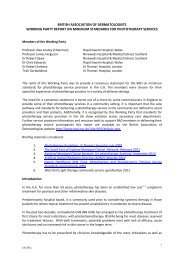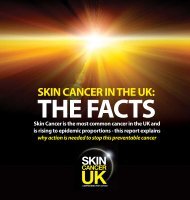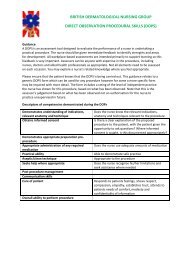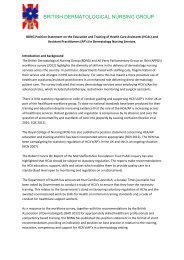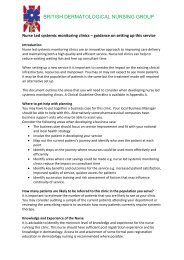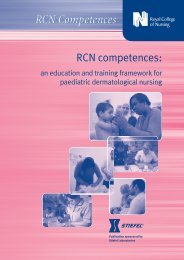Improving outcomes for people with skin tumours including melanoma
Improving outcomes for people with skin tumours including melanoma
Improving outcomes for people with skin tumours including melanoma
You also want an ePaper? Increase the reach of your titles
YUMPU automatically turns print PDFs into web optimized ePapers that Google loves.
<strong>Improving</strong> Outcomes <strong>for</strong><br />
People <strong>with</strong> Skin Tumours<br />
<strong>including</strong> Melanoma<br />
Organisation of <strong>skin</strong><br />
cancer services<br />
Depending on local circumstance, community <strong>skin</strong> cancer clinics could<br />
be based in GPs’ surgeries, community hospitals or diagnostic and<br />
treatment centres where these exist. Patients could be referred to these<br />
clinics by local GPs or members of the LSMDT/SSMDT. For instance,<br />
when a diagnosis of low-risk BCC is made in a dermatology clinic, the<br />
patient may prefer the surgery to be carried out in the community if<br />
the specialist agrees this to be appropriate. Patients could be seen by<br />
these teams <strong>for</strong> treatment and follow-up when appropriate, according<br />
to agreed protocols and patient choice (see Box 1 and Figure 14 <strong>for</strong><br />
details of the patient pathway <strong>for</strong> different types of <strong>skin</strong> lesions).<br />
3<br />
Any doctor or specialist nurse who wishes to treat patients <strong>with</strong> <strong>skin</strong><br />
cancer should have specialist training in <strong>skin</strong> cancer work, be a<br />
member of the LSMDT and undergo ongoing education (see section<br />
on ‘Structure and clinical governance’). In the absence of a national<br />
body to determine the surgical training <strong>with</strong>in the remit of <strong>skin</strong> cancer,<br />
this should be determined by the network site-specific group <strong>for</strong> <strong>skin</strong><br />
cancer and be consistent <strong>with</strong> the NICE Referral guidelines <strong>for</strong><br />
suspected cancer. 29 All doctors participating in the MDT should have a<br />
letter of appointment from the MDT lead clinician. Ideally all doctors<br />
treating patients <strong>with</strong> <strong>skin</strong> cancer should have attended a recognised<br />
<strong>skin</strong> surgical course. They should also work at least one session per<br />
week as a clinical assistant, hospital practitioner, associate specialist or<br />
staff-grade doctor in the local hospital department. This should be in a<br />
parallel clinic <strong>with</strong> an appropriate hospital specialist, normally a<br />
dermatologist, who is a member of the LSMDT/SSMDT. This applies to<br />
GPwSIs as well, as specified in the joint recommendations by the DH,<br />
RCGP and BAD. 30,31 This is considered essential to maintain skills and<br />
promote dialogue <strong>with</strong> the specialist.<br />
29 National Institute <strong>for</strong> Health and Clinical Excellence. Referral guidelines <strong>for</strong> suspected<br />
cancer. Available from: www.nice.org.uk/CG027<br />
30 Department of Health, Royal College of General Practitioners (2003) Guidelines <strong>for</strong> the<br />
appointment of general practitioners <strong>with</strong> special interests in the delivery of clinical<br />
services: dermatology. Available from: www.dh.gov.uk<br />
31 British Association of Dermatologists (2002) Service provision guidelines: GPs <strong>with</strong> a<br />
special interest in dermatology. British Association of Dermatologists’ position statement.<br />
Available from: www.bad.org.uk<br />
64<br />
National Institute <strong>for</strong> Health and Clinical Excellence




